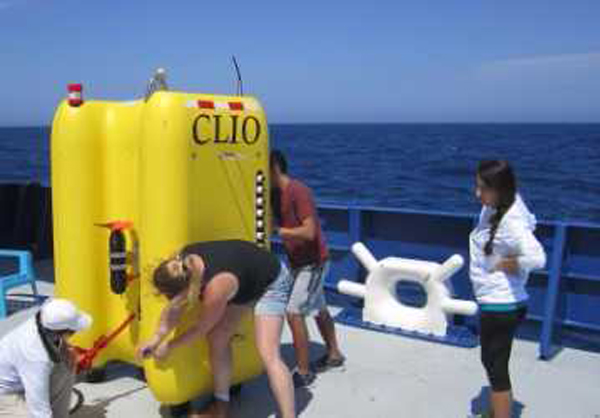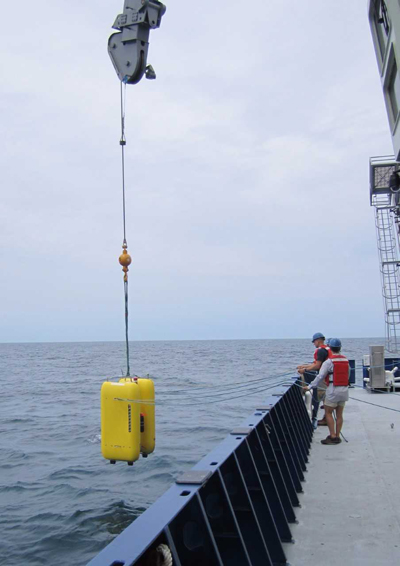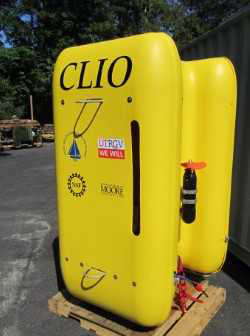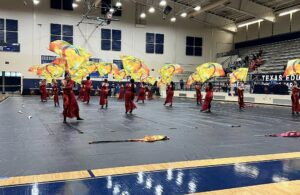- La Feria Community Holds Succesful Business Mixer Event
- Little Nashville to Take Place in Downtown Mercedes
- Lions Basketball Captures District Gold
- La Feria ISD Students Compete in Regional Chess Tournament
- Lions End First Half of 32-4A on a High Note
- La Feria ISD Held Another Successful Parent Conference
- Strong Appearance for Lions at Hidalgo Power Meet
- LFECHS Students Get to Meet Local Actress
- Students Participate in Marine Biology Camp
- Two LFECHS Students Qualify for All-State Band
UTRGV SEEMS Professor Completes Major Sea Trial of the First CLIO, New Class of AUV
- Updated: August 4, 2017

Researchers and students aboard the Research Vessel Neil Armstrong prepare CLIO – the world’s first unmonitored underwater vehicle designed completely for studying the microbiology and biochemistry of the ocean – for underwater testing, where it will filter water for microorganisms. Courtesy Photo
by Steven Masso
BROWNSVILLE, TEXAS – Dr. John “Chip” Breier, associate professor in the UTRGV School of Earth, Environmental and Marine Sciences (SEEMS), has directed a major sea trial of the first of a new class of autonomous underwater vehicles.
Named “CLIO,” the vehicle successfully completed sea trials during a five-day expedition in July aboard the Research Vessel Neil Armstrong.

CLIO is shown being lowered into the water off the Atlantic Continental Shelf, 120 miles south of Cape Cod, Massachusetts. (Courtesy Photo)
CLIO is the world’s first unmonitored underwater vehicle designed completely for the purpose of studying the microbiology and biochemistry of the world’s ocean. The device is named from Greek mythology, after the daughter of Nereus, the old man of the sea.
Breier, chief scientist for the cruise, worked in collaboration with Dr. Mike Jakuba and Dr. Mak Saito of Woods Hole Oceanographic Institution, and Dr. Greg Dick of the University of Michigan at Ann Arbor. The team of scientists successfully completed their mission on Sunday, July 9.
Two UTRGV students – Brianna Alanis who is working on a master’s degree in UTRGV’s new Ocean, Coastal, and Earth Science graduate program, and Javier Garcia, a UTRGV sophomore engineering major from Brownsville – participated in the expedition.
“It was really rewarding to work with so many wonderful people and brilliant minds. We learned so much,” Alanis said.
CLIO successfully completed an untethered dive to 2,000 meters off the Atlantic continental shelf, 120 miles south of Cape Cod, Massachusetts. During that seven-hour dive, CLIO filtered 1,015 liters of seawater for microbiological and biochemical analyses from nine depths.
It is capable of diving to a maximum depth of 6,000 meters – deep enough to reach more than 95 percent of the planet’s seafloor –to collect and preserves chemical and biological samples from the surface to the ocean floor and return them for study. Oceanographers then will measure the genetic and functional diversity of marine microorganisms in the samples, as well as the full suite of nutrients that control that diversity.

CLIO is the work of a four-year project led by Dr. John “Chip” Breier, associate professor in the UTRGV School of Earth, Environmental and Marine Sciences (SEEMS), in collaboration with researchers from the Woods Hole Oceanographic Institution and The University of Michigan at Ann Arbor. The project is funded by the National Science Foundation and the Gordon and Betty Moore Foundation. (Courtesy Photo)
“Microorganisms are the key decomposers of organic matter and recyclers of nutrients on the planet,” Breier said. “They perform a variety of diverse functions critical to all life, like converting dead organic matter back into biologically accessible nutrients, just like microorganisms in garden soil. It’s the same in the ocean, except the ocean is huge and largely unstudied in this regard.”
CLIO’s long-term goal is to help scientists to better understand the microbiology and biochemistry of the ocean and its role in shaping the Earth’s climate.
CLIO is scheduled to begin operational deployments next spring, where it will be used in the Atlantic Ocean to collect microbiological samples from the Sargasso Sea near Bermuda.
“With CLIO now successfully through its sea trials, we are really looking forward to spinning up science operations starting in Bermuda – which will be another exciting opportunity for our students,” Breier said.
The four-year CLIO project has been funded by the National Science Foundation’s Ocean Technology and Interdisciplinary Coordination Program, and the Gordon and Betty Moore Foundation.


